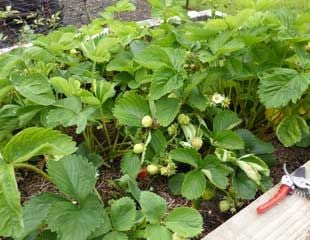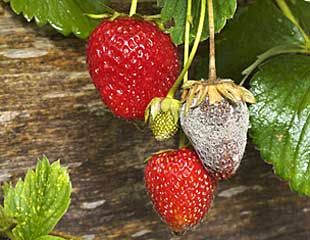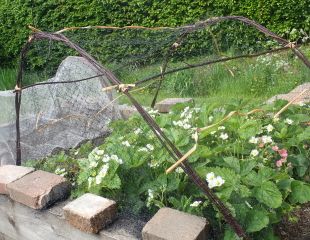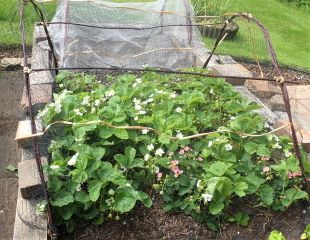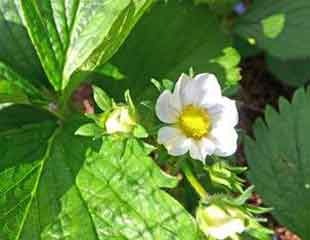
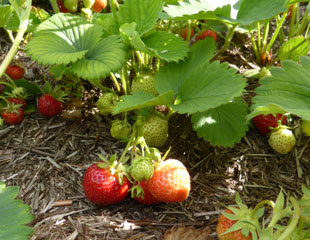
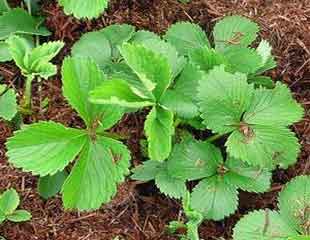
How to grow strawberries
Nothing beats the flavour of a home-grown strawberry picked and eaten warm from the sun. Strawberries are easy to grow and mostly trouble free, requiring a little time and attention to get a crop.
Strawberries are a frost hardy perennial. This means they stay outside all winter and are best planted in a permanent bed. Once you have set out your dedicated strawberry patch, they will withstand our winters and fruit for a few years.
The best time to plant strawberries is in the autumn, but strawberries will grow well planted in the Spring although they may produce less fruit in the first year. Strawberry plants yield fruit best in years 2,3,4 and then usually need replacing. Strawberries prefer good drainage, which makes strawberries ideal for growing in containers (see image below.)
Strawberries have small flowers, usually white or pink (image above) from which the fruits will form. Flowers and fruit are delicate and need protection against dirt splashes and birds. Strawberry fruit is prone to going mouldy if it gets covered in dirty soil splashed up by the rain, and birds love strawberries as much as we do. If not protected, the birds will peck at the fruit, which damages it, and eat the crop. Some form of netting to protect the strawberries is essential, see below.
Growing order for strawberries
- late summer/early autumn cut off a lot of the old foliage, especially any diseased leaves.
- In very cold and frosty areas apply a mulch but take care not to bury the plants, strawberries are prone to botrytis.
- Feed in the spring with high potash feed (such as tomato feed) to encourage flowering. More flowers make for more fruits.
- As soon as the fruits appear, mulch again to prevent the fruit from being splashed.
- Protect with netting/fruit cage.
- During/after harvesting, pot up the runners to make new plants.
Tips on How to plant strawberries
- It is important to plant strawberries at the right level. The crown, which is the bit where the root and stem meet, should be level with the soil and not too deep. If the crown is buried, it can cause rot, particularly if the soil is not well drained or during a wet summer.
- The fruit needs to be protected from soil splashes a mulch of straw or hay will do. I like to use Strulch, which is a light, organic and an ideal mulch for strawberries. To protect the fruit cover the area with a mulch as shown in the middle image above. The Strulch/mulch needs to surround the plant so that the leaves and fruit are lifted above soil level. The image above right shows the strawberry bed mulched with Strulch.
- If you have time, feed with liquid feed from spring onward. Tomato feed is ideal. When feeding and watering, it's important to avoid splashing the leaves which encourage fungal diseases such as Botrytis.
- If you are planting strawberries into containers, plant about 5 plants into a 30 cm/12" container. At the end of the growing season, trim down all the leaves and runners (except those used for new plants see below) and feed. The plants will quickly put on new growth.
- You can grow Strawberries in a hanging basket, and here are some tips and growing advice.
How to make an easy fruit cage
Netting of some sort is inevitable because birds will eat the fruit. Fruit cages are good but they can be expensive. it is easy to make a homemade cage constructed from bamboo sticks, simple connecting joints sold at DIY stores (image below) with net over the top secured in the ground by tent pegs. The netting needs to be raised above the strawberry plants, as the birds will still peck at the fruit if the net is on top of the plants. Also if the netting is too close the plants will grow through the net becoming entangled making it hard to remove and pick the fruit. When making the cage, push the bamboo canes in as far as they will go to withstand the summer gales.
Image below left shows the home made fruit cage, which requires no DIY skills( I have none.)
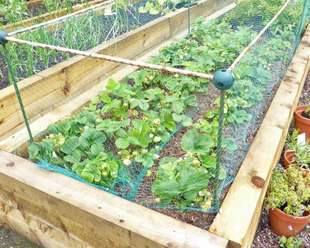
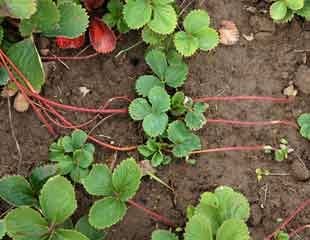
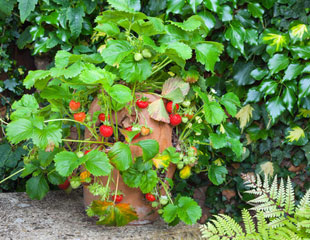
In the 2020 growing season, I constructed a different fruit cage as per the image left, which I thought would look more attractive. I used woven Cornus stems arched over the plants, as shown on the left.
It looked more attractive, or rustic and I thought a good use of garden materials. It deterred the birds, but unfortunately not squirrels. I do not think it entirely coincidental that 2020 was the first and only year that squirrels have eaten my strawberry crop. The two videos below may raise a smile. From now on, I'll revert to the previous design and see if I get lucky, or the Squirrel does.
Making Strawberry Jam set - the best tip.
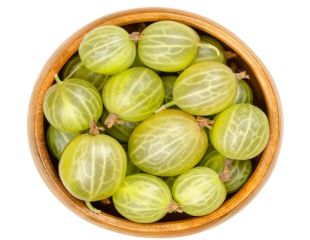
Strawberry jam is notoriously difficult to set because the fruit contains low levels of pectin. Pectin is a naturally occurring substance in fruit which miraculously interacts with the jam making process making it set. With strawberry jam, this can be a toil.
The tip is to add gooseberries to the boiling jam mix. Not so many as to detract from the strawberry jam flavour, but enough to aid setting. For each kilo of strawberries, add about 100-150grams of gooseberries and you will get a fantastic set.
I was given this tip by a Dorset farmer many years ago when picking my own strawberries and it never fails.
Best varieties of strawberries to grow
Strawberries which the RHS has tried and tested as giving good yields and flavours are 'Alice' 'Cambridge Favourite' 'Hapil' and 'Pegasus' together with those listed below as ideal for containers. I have also had good crops with sweet, tasty fruit from 'Albion' 'Red Gauntlet' along with 'Symphony' and 'Honeoye'
Best Strawberry Varieties for Growing in Containers
Strawberries are an ideal crop to grow in containers, including hanging baskets. Place the container in a sunny spot, and because containers are a smaller environment, (which dry out more easily,) the plants will need regular watering and feeding.
In 2016-2017 the RHS conducted trials to establish the best varieties of strawberries to grow in containers, which included hanging baskets and grow bags. There are some advantages to growing in hanging baskets and grow bags as they are raised from the ground, which means the crop is kept away from ants, which can be a pest, and there is better air circulation to reduce problems with Botrytis. In addition, the fruit is cleaner when it is not directly on the soil.
Video on YouTube about Growing Strawberries in hanging baskets.
Those which already have the RHS award are 'Cambridge Favourite' 'Honeoye', 'Pegasus', 'Rhapsody' and 'Symphony'. For grow bags the trial found the best varieties to be 'Finesse' 'Florence' and 'Vibrant' and 'Evie 3' all of which have the AGM award. A suggested suggested variety for hanging baskets (none of which have the AGM) 'Delizz' (Liza) .'Eros' and 'Mae' are reported to be more disease resistant, 'Elegance' and 'Sweet Colossus' large crops and fruit.
These are all good ideas, but sometimes you have to buy what you can get and any variety of strawberry will grow well in a container.
Growing Alpine Strawberries
Alpine and wild strawberries have become popular, even trendy. They are tiny, delicate strawberries. If you grow this variety, a word of warning. Strawberries are a vigorous plant and wild berries are even more so. Some years ago I was given a batch of Alpine Strawberries. At the time, having I had nowhere to plant them being in a new garden not yet laid out. I temporarily put them in a part of a border to move them later, which I did.
Years later, I am still weeding wild strawberry plants out of the borders, where they root mercilessly, and are almost impossible to eradicate. I recommend if you want to grow wild strawberries to make sure they cannot escape their planting area and they would be ideal for container planting.
How to get an early crop of strawberries
To ensure good fruiting strawberries, need a period of cold during the winter. By about February, it is possible to warm up the soil and plants to bring on an earlier crop. By covering the plants with a cloche, you can raise an earlier crop.
Early in the season, pick over the plants to remove any dead or diseased leaves and stray runners. Make sure the area is clear of weeds and add some new compost. Cover the area with a cloche and early in the season, I would also seal the ends of the cloche for maximum warmth. As the season warms up, remove the cloche ends and later remove the cloche altogether on warm days to allow air and the pollinators in.
Lift and water under the cloche to keep the plants well hydrated. Placing a cloche over the strawberries,early in the season, does make a difference to get an earlier crop.
How to get strawberry plants for free
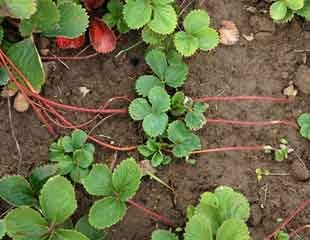
As the season progresses, strawberry plants put out runners which are leads from the plants with a tiny plant on the end. Runners are shown in the image left. Mostly during the growing season, it is best to cut off runners to divert the plant energy into fruiting, not making more runners.
Later in the season, these runners can make new plants which, given the short life of strawberries, 4-5 years, helps to replenish the stock of plants. Peg the runner and plant either in the ground or put a small plant pot filled with good compost underneath. Leave for a few weeks until well rooted, then cut off the runner separating it from the main plant. Grow on and pot on the small plant, putting it into the strawberry bed replacing one of the older plants which is providing less fruit.
Problems with Strawberries
The most common disease with strawberries is botrytis, grey mould which is more of a problem in cool, wet summers. Commercial strawberry growers often spray with fungicides to prevent Botrytis but the problem is more tricky for gardeners. Botrytis lives in dead plant tissue, such as old strawberry leaves and leaf stalks provide material for the fungus to live on and to produce spores. The infection starts during the flowering period, (although it is not visible) although the disease remains inactive until the fruit develops. It causes the fruits to rot, as shown in the image below right.
If Botrytis strikes, cut off all infected leaves, together with any leaves showing signs of discolouration, and remove infected fruit. Clear up around all plants to remove any decaying leaves. Increase air circulation by removing some extra (healthy) leaves, stake the plants to keep upright, and allow the air to circulate and hope for a dry spell for the plants to recover.
The images below show you can cut off a good amount of the leaves, strawberries are vigorous plants, and as you remove leaves, you will see at the base of the plant fresh leaves growing so be bold to try to stop the infection. Botrytis will attack all parts of the Strawberry plant and the fruit will rot before it ripens, very frustrating and given our propensity to wet summers, it can be a problem. As always with plant diseases, do not compost the leaves and waste material.
Strawberry plants only live for 4-5 years and so if it is a severe attack, and the plants are getting elderly, consider if this is time to replace them. More about this problem: Sunday Gardener's Blog Growing Strawberries and Botrytis.
